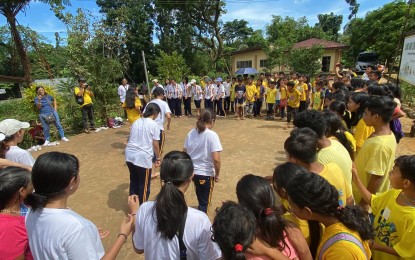
INTERCULTURAL IMMERSION. Students of St. Theresa's College of Quezon City are welcomed by youths of the TUGDAAN Mangyan Center for Learning and Development in Naujan town, Oriental Mindoro province on Friday (Feb. 2, 2024). The welcome rites were done in traditional Mangyan fashion. (Photo courtesy of Cyrus Valencia)
NAUJAN, Oriental Mindoro – It was a day of both fun and learning for city and rural students during an exposure-interaction trip in this town over the weekend.
Some 50 student leaders of Saint Theresa's College of Quezon City (STCQC) traded insights and experiences with their youth counterparts at the TUGDAAN Mangyan Center for Learning and Development (TMCLD) here.
An STCQC official who joined the students explained that the exposure-interaction trip was part of their school’s Leadership Enhancement and Development (LEAD) Program, intended “to foster intercultural understanding and appreciation” between the urban youths and their indigenous peoples (IP) counterparts.
In an interview on Sunday, Cyrus Valencia, teacher and LEAD Program facilitator at STCQC, said his school’s delegation consisted of student council officers, Grade 11 and 12 class officers, six faculty members and the school nurse.
The STCQC delegation arrived at the Calapan Port aboard a Montenegro Shipping Lines ferry boat on Friday morning, and immediately embarked on the roughly 24-kilometer road trip to the school for IP youths, located in Barangay Paitan at the foot of Mount Halcon.
Upon their arrival at the TMCLD’s 9-hectare campus, the students from Metro Manila were warmly welcomed by their Mangyan hosts through a series of tribal rituals and cultural presentations.
The welcome rites prepared for the visitors included a rendition of the Tarok folk dance about farming, a group song highlighting unity among Mindoro’s eight unique Mangyan tribes, and their version of the Ambangan courtship chant.
What followed was a series of cultural exchange activities that lasted until Saturday afternoon, according to religion teacher Valencia.
The “Theresians” also distributed food, school supplies as well as symbolic gifts to their young Mangyan hosts.
A nature walk at the Infinity Farm in nearby Baco town capped the STCQC students' provincial jaunt.
“(We are seeking to) develop among Theresian leaders the consciousness of inter connectedness, spirit of solidarity in their mission for service," Valencia pointed out.
For her part, STCQC student council president Adelene Naig recounted how their hosts brought them to the Mangyan Heritage Center, referred to as a “sacred place” that serves as a repository for artifacts relevant to the eight tribes’ history, culture and livelihood.
She said members of her party were forbidden to take photographs or get too rowdy there in deference to Mangyan sensibilities.
“What struck me most was how the youth of Mangyan viewed their culture… For them, culture and nature are things that they revere, as they form the foundation of their identities and humanities,” she said.
Naig stressed that the insights gleaned from interacting with their Mangyan counterparts made the long and uncomfortable voyage by bus and “Ro-Ro” (Roll on-Roll off) ferry boat worthwhile.
For her part, TMCLD student “Irene” said the visit by STCQC campus leaders was an eye-opening experience for her schoolmates, who got a glimpse of the broader society through their guests.
“We are glad that you showed respect to our culture. Even if we live far away, you made the effort to visit and mingle with us,” she told the visitors in Filipino.
Meanwhile, Valencia noted how the method of teaching at TMCLD is tailor-made for the community it serves, and is different in some respects from the way things are done at STCQC.
“Their curriculum is distinct to their culture and is supported by DepEd (Department of Education). Their teachers, including administrators, are mostly Mangyans who are also graduates of the school,” he added.
The TMCLD is an educational institution built to serve the eight Mangyan tribes of Oriental and Occidental Mindoro.
It was established in 1989 after consultations with the tribal elders who complained of being discriminated against and tricked by lowlanders, and felt this was all due to their lack of education, according to the IP school’s website. (With a report from Dominique Joy Rustia /PNA)
